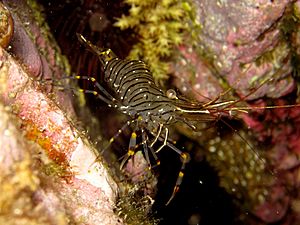Rockpool shrimp facts for kids
Quick facts for kids Rockpool shrimp |
|
|---|---|
 |
|
| Scientific classification | |
| Genus: |
Palaemon
|
| Species: |
elegans
|
The rockpool shrimp, known scientifically as Palaemon elegans, is a small sea creature. It belongs to a group of animals called shrimp, which are part of the Palaemonidae family. These shrimps are often found in shallow waters and rockpools.
Rockpool shrimps are native to many parts of the world. This means they naturally live there. Their native homes include the eastern North Atlantic Ocean, the Baltic Sea, the Mediterranean Sea, and the Black Sea. They have also been introduced to other places, like the Caspian Sea and Aral Sea. This means humans moved them there, and they started living in these new areas.
Contents
Meet the Rockpool Shrimp
The rockpool shrimp is a fascinating creature. It is a type of crustacean, just like crabs and lobsters. These shrimps are well-adapted to living in the changing conditions of rockpools. They can handle changes in temperature and how salty the water is.
What Does It Look Like?
Rockpool shrimps are usually quite small. They have a clear or slightly colored body, which helps them blend in with their surroundings. Like all shrimps, they have a hard outer shell called an exoskeleton. This shell protects their soft bodies. They also have long antennae, which they use to feel their way around and find food. Their legs are used for walking and swimming.
Where Do Rockpool Shrimps Live?
These shrimps love to live in rockpools. Rockpools are small pools of water left behind on the shore when the tide goes out. They can also be found in shallow coastal waters. They often hide among rocks and seaweed to stay safe from predators.
Native Homes
- Eastern North Atlantic: This includes the coasts of Europe and parts of Africa.
- Baltic Sea: A sea in Northern Europe.
- Mediterranean Sea: A large sea connecting Europe, Africa, and Asia.
- Black Sea: Another sea located between Europe and Asia.
New Homes (Introduced Areas)
- Caspian Sea: The world's largest inland body of water.
- Aral Sea: A large lake in Central Asia.
Rockpool Shrimp and Other Species
The Palaemon elegans shrimp looks a lot like three other types of shrimp in the same group. These are Palaemon serratus, Palaemon longirostris, and Palaemon adspersus. Sometimes, it can be hard to tell them apart!
In some places, the rockpool shrimp has become an invasive species. This means it has moved into new areas and started to take over. It can sometimes outcompete or replace other native shrimp species, like Palaemon adspersus. This can change the balance of the ecosystem in those areas.
Life Cycle and Reproduction
Like many sea creatures, rockpool shrimps have an interesting life cycle. They start as tiny eggs and go through several stages before becoming adult shrimps.
How They Reproduce
Female rockpool shrimps carry their eggs under their tails. Once the eggs hatch, tiny larvae are released into the water. These larvae float and swim in the water, feeding on small particles. As they grow, they go through several molts. A molt is when they shed their old, small shell and grow a new, larger one. This allows them to grow bigger. After several molts, they develop into miniature versions of adult shrimps. They then settle down and continue to grow.
What Do Rockpool Shrimps Eat?
Rockpool shrimps are omnivores. This means they eat both plants and animals. They are often scavengers, eating small bits of food they find in their environment. Their diet can include:
- Tiny pieces of algae
- Small dead animals
- Detritus (decaying organic matter)
- Other very small organisms
They use their small claws to pick up food and bring it to their mouths.
Why Are Rockpool Shrimps Important?
Rockpool shrimps play a role in their ecosystems. They help to clean up by eating dead material. They also serve as a food source for other animals, like fish and birds. Understanding these shrimps helps us learn more about the health of our coastal environments.
See also
 In Spanish: Palaemon elegans para niños
In Spanish: Palaemon elegans para niños

